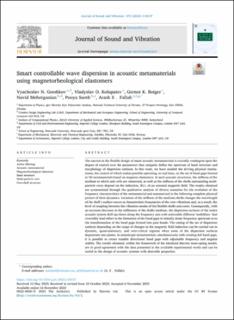| dc.description.abstract | The success in the flexible design of smart acoustic metamaterials is crucially contingent upon the
degree of control over the parameters that uniquely define the spectrum of band structure and
morphology of dispersion surfaces. In this work, we have studied the driving physical mecha-
nisms, the control of which makes possible operating, in real-time, on the set of band gaps formed
in 3D metamaterials based on magneto elastomers. In such acoustic structures, the stiffness of the
medium in which unit cells are immersed, as well as the stiffness of the shells surrounding multi-
particle cores depend on the induction, B(t), of an external magnetic field. The results obtained
are systematized through the qualitative analysis of diversе scenarios for the evolution of the
frequency characteristics of the metamaterial and summarized in the following complete physical
picture of their dynamics. Variation of the stiffness of the medium/shells changes the wavelength
of the shell’s surface waves at characteristic frequencies of the core vibrations and, as a result, the
level of coupling between the vibration modes of the flexible shells and cores. Consequently, with
an increase/decrease in the stiffnesses of the shells/medium, the dispersion surfaces of the entire
acoustic system shift up/down along the frequency axis with noticeably different ‘mobilities’ that
reversibly lead either to the formation of the band gaps in initially dense frequency spectrum or to
the transformation of the band gaps formed into pass bands. The tuning of the set of dispersion
surfaces depending on the range of changes in the magnetic field induction can be carried out in
dynamic, quasi-stationary, and over-critical regimes when some of the dispersion surfaces
degenerate into planes. In anisotropic metamaterials, simultaneously with creating full band gaps,
it is possible to create tunable directional band gaps with adjustable frequency and angular
widths. The results obtained, within the framework of the idealized discrete mass-spring model,
are in good agreement with the data presented in the available experimental works and can be
useful in the design of acoustic systems with desirable properties. | en_US |

